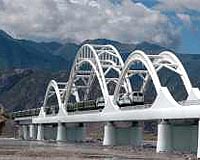| . |  |
. |
Barecelona, Spain (SPX) Dec 16, 2010 High-speed trains consume 29% less energy than conventional trains per passenger transported, and reduce CO2 emissions by the same proportion. These are the conclusions of a study by the Spanish Railways Foundation published in the journal Transportation Research Record. "A high speed train operating in normal conditions consumes less energy and produces less CO2 emissions per passenger transported (on average 29% less) than a conventional train travelling between the same two points at a lower speed", Alberto Garcia, author of the study and a researcher at the Spanish Railways Foundation, tells SINC. The engineer explains that the AVE consumes less due to the intrinsic features of the high speed system, "such as its more standardised speed profile and the lower number of stops and curves during the journey". The consumption of auxiliary services (air conditioning, lighting and ventilation) is also reduced in direct proportion to speed. With regard to emissions, high speed trains use an electric traction system, meaning they do not emit greenhouse gases and contribute less to fossil fuel consumption than other means of transport. In this respect they are the same as other electric trains. Alberto Garcia stresses that the prime advantage of a high speed line is not in substituting conventional trains, but rather in attracting a large number of travellers who would otherwise travel by aeroplane and private car.
Fewer gases emitted into the atmosphere In order to carry out the study, which has been published in the journal Transportation Research Record, the engineer used 2008 data and a simulator developed by the Spanish Railways Foundation, validated by the records from more than 15 years of high speed train operations. The mathematical simulator has made it possible to cross-reference almost 200 variables related to the conventional train and the AVE (track characteristics, number of stops, electrical systems, correction coefficients, etc.) on 10 medium and long distance journeys. The study includes the two high speed lines inaugurated this week - Madrid-Valencia and Madrid-Albacete.
Share This Article With Planet Earth
Related Links FECYT - Spanish Foundation for Science and Technology Great Train Journey's of the 21st Century
 China, Laos to start work on high-speed rail link in 2011
China, Laos to start work on high-speed rail link in 2011Beijing (AFP) Dec 8, 2010 China and Laos will begin construction early next year of the first high-speed rail line between the two countries, a report said Wednesday, as part of a project to link China and Southeast Asia. The bullet-train rail line will be completed in around 2014, Laotian Deputy Prime Minister Somsavat Lengsavad was quoted by the Wall Street Journal as saying. Landlocked Laos, which has one of t ... read more |
|
| The content herein, unless otherwise known to be public domain, are Copyright 1995-2010 - SpaceDaily. AFP and UPI Wire Stories are copyright Agence France-Presse and United Press International. ESA Portal Reports are copyright European Space Agency. All NASA sourced material is public domain. Additional copyrights may apply in whole or part to other bona fide parties. Advertising does not imply endorsement,agreement or approval of any opinions, statements or information provided by SpaceDaily on any Web page published or hosted by SpaceDaily. Privacy Statement |